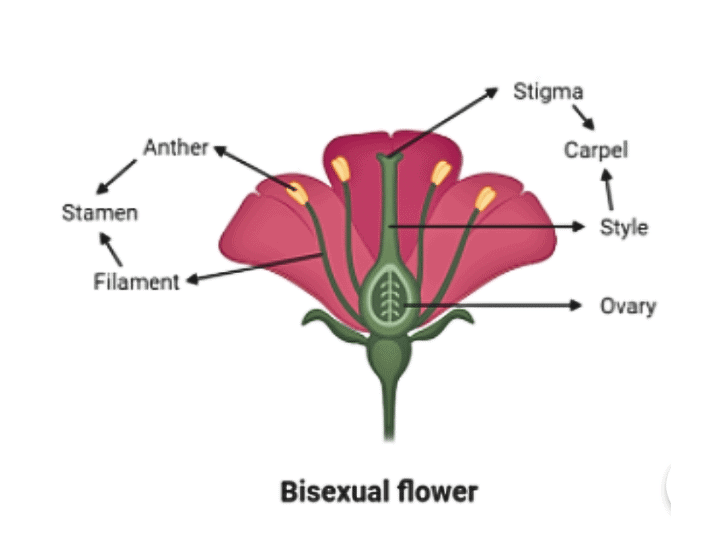Reproduction in Plants Class 7 Notes Science Chapter 8
| Table of contents |

|
| Modes of Reproduction |

|
| Asexual Reproduction |

|
| Sexual Reproduction |

|
| Fruits and Seeds Formation |

|
| Seed dispersal |

|
All living things, including plants, have the special ability to create new life. You’ve learned before that this process is called reproduction. But have you ever wondered how plants, which stay in one place and don’t move around like animals, are able to make new plants?
In this chapter, we’ll look at the different ways plants reproduce and learn how they bring new plants into the world.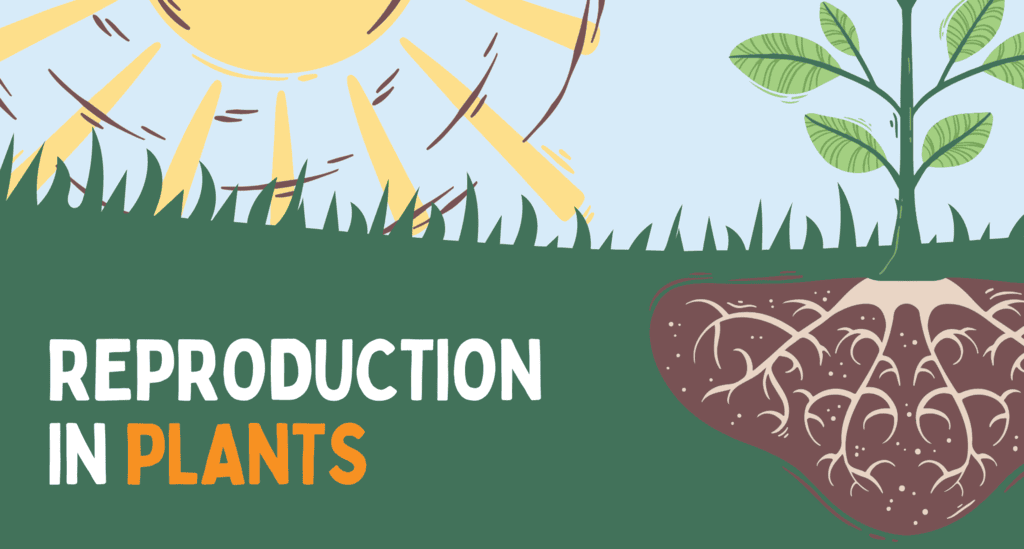
Modes of Reproduction
- Plants consist of roots, stems, and leaves, collectively termed as vegetative parts.
- After a growth period, most plants develop flowers, such as mango trees blooming in spring.
- Flowers are crucial for the reproduction of plants and serve as their reproductive parts.
- The flowers of plants eventually give rise to fruits, like juicy mangoes enjoyed in summer.
- Although we typically consume the fruits and discard the seeds, these seeds play a vital role in germination and the formation of new plants.
- There are two modes of reproduction: asexual and sexual reproduction. Asexual reproduction does not involve the production of seeds.
- A flower may contain either male or female reproductive parts.

Asexual Reproduction
Asexual reproduction creates new plants that are similar to the parent plant. Different parts of the plant, like corms, stem tubers, rhizomes, and stolon, help in this type of reproduction.
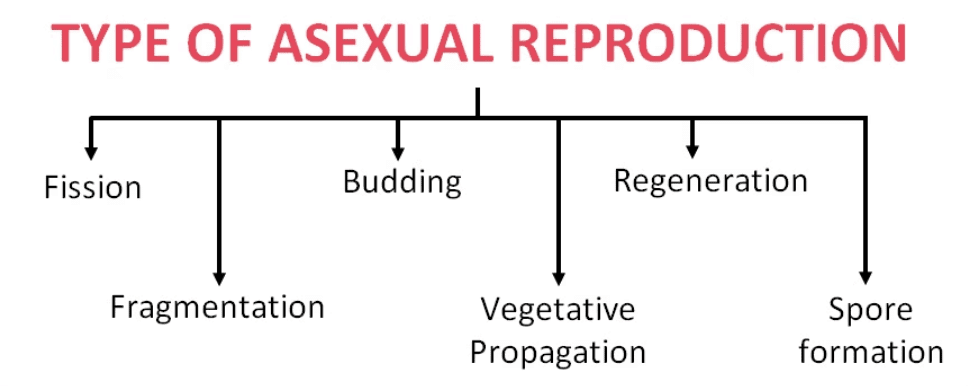
1. Vegetative Propagation
It is a type of asexual reproduction in which new plants are produced from roots, stems, leaves and buds. Since reproduction is through the vegetative parts of the plant, it is known as vegetative propagation.
(i) Vegetative Reproduction by Stem
- Stem Cutting: It is a method in which a cutting from a plant is taken and planted. This cutting is a part of the stem or the branch of the plant. Example: Roses
- In this method, the small part of the stem is removed by cutting with a sharp knife.
- The stem cutting must have some buds on it.
- Now the lower end of the stem cutting is buried in the moist soil.
- The upper part of the cutting, having a bud on it, is kept above the soil.
- After a few days, this cutting develops new roots.
- The bud grows and produces a shoot (i.e. branches with leaves).
- Thus, a new plant is produced that is exactly similar to the parent plant, e.g., champa, grapes, sugarcane, banana, etc.
- Plants like cacti create new plants when their parts separate from the main plant. Each detached piece has the potential to develop into a new plant.
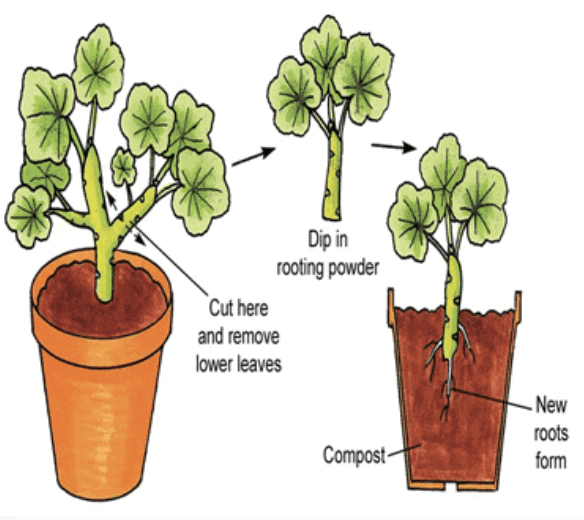 Stem Cutting
Stem Cutting
- Stem Tubers: Just like tuberous roots, some plants have tuberous stems. These stem tubers store the nutrients and bear nodes. These nodes bear buds that form the new plants.
Potato "eyes" are small buds on a potato that can grow into new plants. When planted, each eye sprouts into a stem, which grows into a new potato plant underground.
Potato Eyes
(ii) Vegetative Reproduction by Leaves
Bryophyllum (sprout leaf plant) plant has buds on the edges of its leaves.
When the buds come in contact with moist soil, each bud is capable of growing into a new plant.
(iii) Vegetative Reproduction by Roots.
- Roots that store food are known as tubers.
- Such roots are the food storage tanks for the plants.
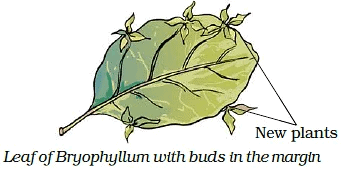
- When these tubers are detached from the parent plant and planted in the soil, they grow into a new plant.
- Another plant that is grown from the tuber is the dahlia plant.
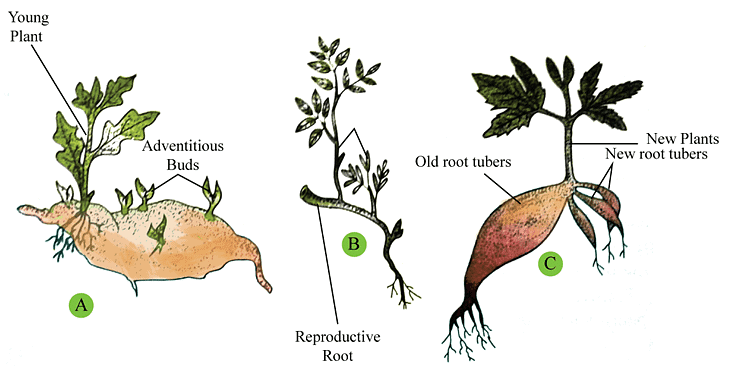 Vegetative Reproduction
Vegetative Reproduction
2. Budding
Budding is a type of asexual reproduction where a new organism grows directly from the body of the parent. A small bud forms on the parent plant, grows, and separates to become an independent individual.
- A small projection known as a bud forms on the yeast cell.
- This bud grows, detaches, and becomes a separate yeast cell.
- The new yeast cell then grows and can generate more buds.
- Sometimes, a series of buds can appear, with one bud growing from another.
- This process can lead to a rapid increase in the number of yeast cells.
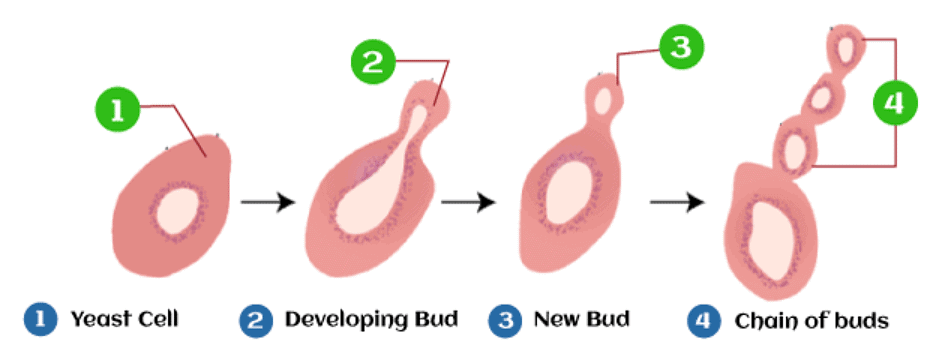 Budding in Yeast Cells
Budding in Yeast Cells
3. Fragmentation
- Green algae, such as Spirogyra, typically reproduce through a method called fragmentation, where the algae split into two or more pieces.
- When there's enough water and nutrients, these algae grow and quickly multiply by breaking apart. Each piece can develop into a new organism.
- This cycle continues, allowing them to spread over a large area rapidly.
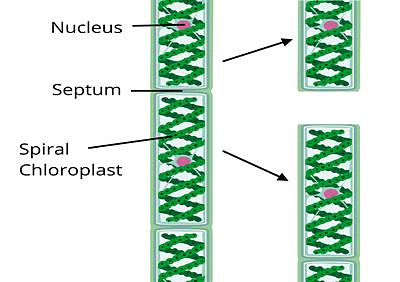 Fragmentation in Spirogyra
Fragmentation in Spirogyra
4. Spore Formation
- Some plants contain spores that float in the air and cause asexual reproduction.
- Fungi, like those found on bread, originate from spores that are carried by the air.
- A spore has a tough outer covering that shields it from harsh conditions such as temperature and humidity.
- This allows spores to travel and remain viable for a long time.
- When they encounter suitable conditions, such as moisture and nutrients, they sprout and develop into new plants.
- Sporangium is a structure in fungi and some plants that generates and holds spores.
- Hyphae are long, branching structures found in fungi.
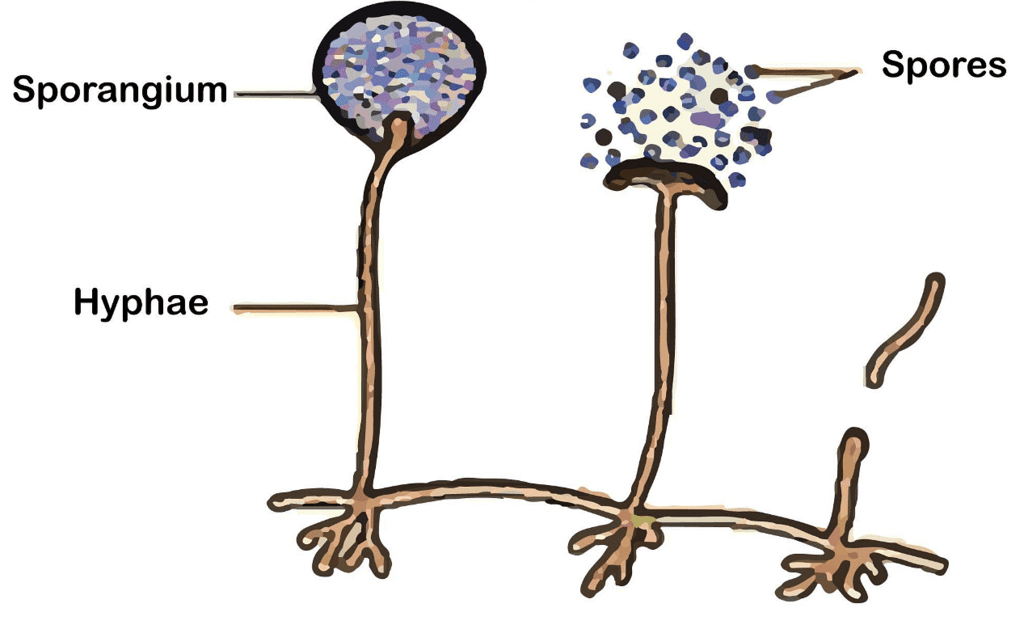 Spore Formation in Fungus
Spore Formation in Fungus
Advantages of vegetative propagation:
- Plants grow more quickly and produce flowers and fruits earlier than those grown from seeds.
- They are identical copies of the parent plant.
- They come from a single parent plant.
Sexual Reproduction
In sexual reproduction, new plants are obtained from seeds. Sexual reproduction in plants involves the joining of male and female parts of a flower.
The male part (stamen) produces pollen, which is transferred to the female part (pistil) through pollination. When pollen reaches the pistil, fertilization occurs, leading to the formation of seeds that can grow into new plants.
Anther and Pistil
- The new plant produced contains the characteristics of both plants that participate in the sexual reproduction.
- The stamen consists of Anther that has pollen grains.
- These pollen grains produce male gametes.
- The pistil consists of three parts:
- Stigma – It is a sticky surface where pollen grains get attached.
- Style – It is a tube-like structure which connects the stigma and the ovary.
- Ovary – It contains eggs in which the female gametes or eggs are formed.
- The female gamete, also known as the egg, develops within an ovule.
- In the process of sexual reproduction, a male gamete and a female gamete combine to create a zygote.
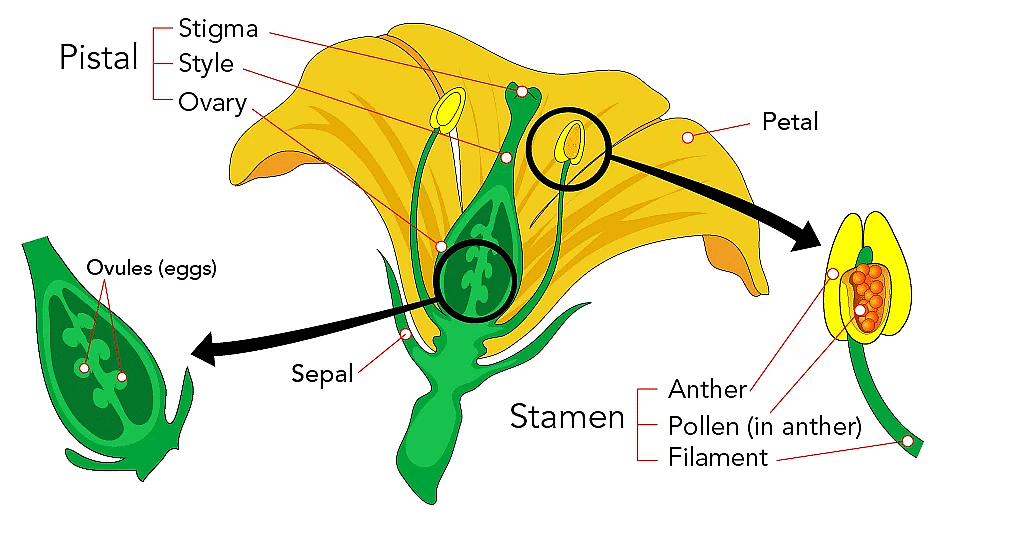 Sexual Reproduction
Sexual Reproduction
Types of Flower
Bisexual Flowers- Some flowers have both stamen and pistil and are known Bisexual Flowers. Example: Lily, rose, brinjal, hibiscus, petunia, mustard etc.
Unisexual Flowers- Some flowers contain either the stamen or the pistil and hence are called Unisexual Flowers. Example: Papaya, watermelon, cucumber, coconut etc.
Unisexual Flowers
Pollination
The transfer of pollen from the anther to the stigma of a flower constitutes pollination.
Pollination Process Overview:
- Pollen grains have a protective coat to prevent drying up.
- They are light and can be transported by wind, water, or insects.
Insect-mediated Pollination:
- Insects visit flowers and unintentionally carry pollen on their bodies.
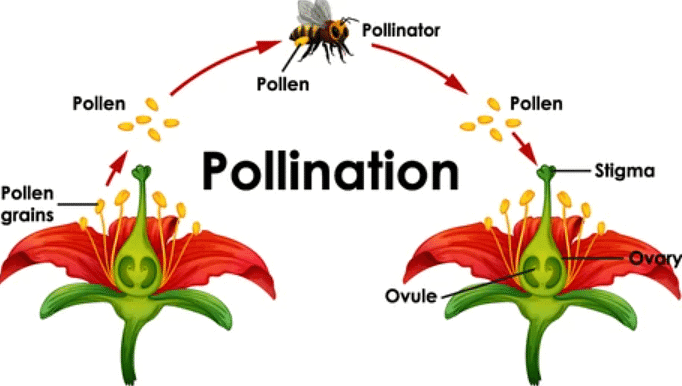 Pollination
Pollination
There are two types of pollination:
Self-Pollination:
- Pollen lands on the stigma of the same flower or another flower of the same plant.
- This process is known as self-pollination.
Cross-Pollination:
- Pollen from a flower lands on the stigma of a different plant of the same kind.
- This is referred to as cross-pollination.
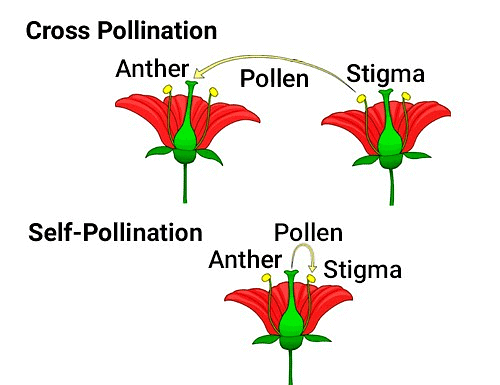 Types of Pollination
Types of Pollination
Fertilization
Fertilization takes place when pollen reaches the stigma of a flower, enabling the joining of male and female gametes to create a zygote. This zygote then evolves into an embryo.
This process of creation of the zygote is referred to as fertilization.
 Fertilization Process
Fertilization Process
Fruits and Seeds Formation
- Once fertilization occurs, the ovary transforms into a fruit.
- Other components of the flower detach during this time.
- The fruit is essentially the matured ovary.
- Seeds emerge from the ovules.
- A seed comprises an embryo shielded by a protective coat.
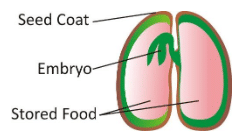 Structure of a Seed
Structure of a Seed
Fruits can be categorised into two types based on texture:
- Some fruits, like mangoes and oranges, are fleshy and juicy.
- Others, such as almonds and walnuts, have a hard texture.

Seed dispersal
- In nature, similar types of plants grow in different places as seeds are carried to various locations. When you walk through a forest, field, or park, you might find seeds or fruits sticking to your clothes.
- Plants of the same type grow in different places due to seed dispersal.
- Seeds are scattered to various locations naturally.
Consequences of Limited Dispersion:
If all seeds of a plant fall and grow in the same place:
- Severe competition for sunlight, water, minerals, and space occurs.
- Results in unhealthy plant growth.
Methods of Seed Dispersal:
- Wind: Winged seeds (e.g., drumstick, maple) and light seeds of grasses get blown to distant places. Hairy seeds of aak (Madar) and hairy fruit of sunflower get blown off to far places.
- Water: Some seeds develop floating ability (e.g., coconut) for dispersal by water.
- Animals: Spiny seeds with hooks attach to animals, carrying seeds to distant places (e.g., Xanthium, Urena).
- Bursting Fruits: Some fruits burst with sudden jerks, scattering seeds far from the parent plant. Examples: castor and balsam.
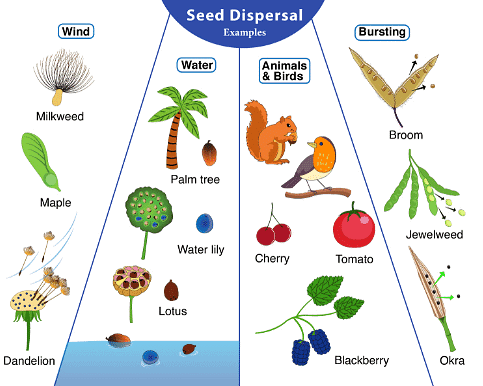
|
111 videos|435 docs|28 tests
|
FAQs on Reproduction in Plants Class 7 Notes Science Chapter 8
| 1. What is the difference between asexual and sexual reproduction in plants? |  |
| 2. How do fruits and seeds form in plants? |  |
| 3. What are some common methods of seed dispersal in plants? |  |
| 4. Why is seed dispersal important for plants? |  |
| 5. What are some examples of asexual reproduction in plants? |  |

